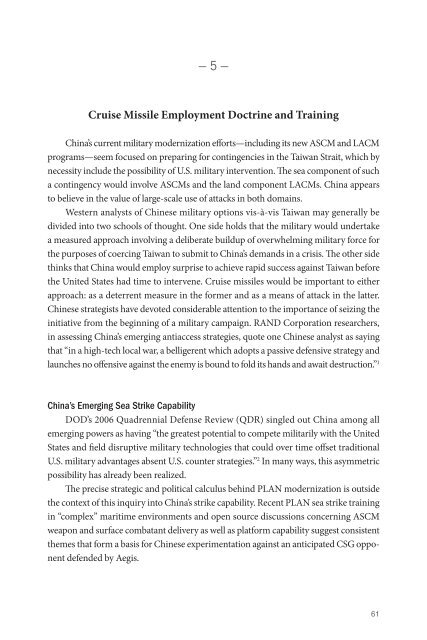You also want an ePaper? Increase the reach of your titles
YUMPU automatically turns print PDFs into web optimized ePapers that Google loves.
— 5 —<br />
Cruise Missile Employment Doctrine and Training<br />
China’s current military modernization efforts—including its new ASCM and LACM<br />
programs—seem focused on preparing for contingencies in the Taiwan Strait, which by<br />
necessity include the possibility of U.S. military intervention. The sea component of such<br />
a contingency would involve ASCMs and the land component LACMs. China appears<br />
to believe in the value of large-scale use of attacks in both domains.<br />
Western analysts of Chinese military options vis-à-vis Taiwan may generally be<br />
divided into two schools of thought. One side holds that the military would undertake<br />
a measured approach involving a deliberate buildup of overwhelming military <strong>force</strong> for<br />
the purposes of coercing Taiwan to submit to China’s demands in a crisis. The other side<br />
thinks that China would employ surprise to achieve rapid success against Taiwan before<br />
the United States had time to intervene. Cruise missiles would be important to either<br />
approach: as a deterrent measure in the former and as a means of attack in the latter.<br />
Chinese strategists have devoted considerable attention to the importance of seizing the<br />
initiative from the beginning of a military campaign. RAND Corporation researchers,<br />
in assessing China’s emerging antiaccess strategies, quote one Chinese analyst as saying<br />
that “in a high-tech local war, a belligerent which adopts a passive defensive strategy and<br />
launches no offensive against the enemy is bound to fold its hands and await destruction.” 1<br />
China’s Emerging Sea Strike Capability<br />
DOD’s 2006 Quadrennial Defense Review (QDR) singled out China among all<br />
emerging powers as having “the greatest potential to compete militarily with the United<br />
States and field disruptive military technologies that could over time offset traditional<br />
U.S. military advantages absent U.S. counter strategies.” 2 In many ways, this asymmetric<br />
possibility has already been realized.<br />
The precise strategic and political calculus behind PLAN modernization is outside<br />
the context of this inquiry into China’s strike capability. Recent PLAN sea strike training<br />
in “complex” maritime environments and open source discussions concerning ASCM<br />
weapon and surface combatant delivery as well as platform capability suggest consistent<br />
themes that form a basis for Chinese experimentation against an anticipated CSG opponent<br />
defended by Aegis.<br />
61


